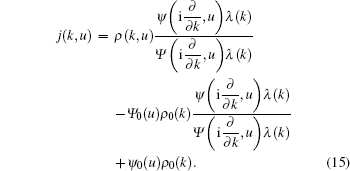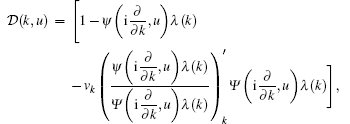† Corresponding author. E-mail:
‡ Corresponding author. E-mail:
Project supported by the Foundation for Young Key Teachers of Chengdu University of Technology, China (Grant No. KYGG201414) and the Opening Foundation of Geomathematics Key Laboratory of Sichuan Province, China (Grant No. scsxdz2013009).
Anomalous (or non-Fickian) transport behaviors of particles have been widely observed in complex porous media. To capture the energy-dependent characteristics of non-Fickian transport of a particle in flow fields, in the present paper a generalized continuous time random walk model whose waiting time probability distribution depends on the preceding jump length is introduced, and the corresponding master equation in Fourier–Laplace space for the distribution of particles is derived. As examples, two generalized advection-dispersion equations for Gaussian distribution and lévy flight with the probability density function of waiting time being quadratic dependent on the preceding jump length are obtained by applying the derived master equation.
The most popular model for describing the behavior of particle transport in fluid fields is the advection-dispersion equation (ADE) based on Fick’s diffusion law in hydrology and related sciences.[1–6] However, in recent years many tracer tests in natural complex porous media exhibit anomalous dispersion behavior deviating from Fickian diffusion, and the classical ADE is no longer suitable for describing this kind of tracer transport.[7–10]
One of the effective ways to quantify anomalous (or non-Fickian) transport in nonhomogeneous porous media is the continuous time random walks (CTRW’s) model.[11–16] Based on various CTRW’s scholars obtain several generalization types of ADE, which can be used to describe the evolution of the probability density function (PDF) of the particles undergoing anomalous dispersion in flow fields.[17,18] Note that an assumption in the used CTRW models is that the energy of the non-Fickian particles does not have a direct effect on their transport behaviors. But in fact, the random sojourn times of the anomalous particles under certain circumstances maybe depend on their energy.
In 2006, Zaburdaev proposed a CTRW model in which the waiting time is connected with the preceding jump length. This model describes the dependence of the random waiting time on the energy and suggests a method that includes the details of the microscopic distribution over the waiting times and arrival distances at a given point.[19] Note that this generalized model has not been associated with the external velocity for the walking particle. As we know, to capture the behaviors of particle transport in moving fluids, the affect of convection velocity should be further considered.[17,20] One of the main aims of the present paper is to develop the CTRW model introduced by Zaburdaev coupling with a nonhomogeneous velocity field. Our generalized CTRW model can describe the behavior of the energy-dependence of random waiting time, and represent the influence of the velocity field on anomalous dispersion. In addition, we derive the corresponding master equation in the Fourier–Laplace domain from which the generalized ADE can be obtained in the macroscopic limit. As examples, we shall apply the new master equation to derive two generalized ADE’s for Gaussian distribution and lévy flight in linear flows when the microscopic distribution of the random sojourn time is quadratic dependent on the preceding jump length.
For the generalization to anomalous transport in a fluid field, we first give the classical decoupled memory CTRW model in the one-dimensional case.[17,20–25] In this scheme, the particle jumps from x to x + y with jump length PDF λ(y), and the waiting time before the particle makes two consecutive jumps has PDF ψ(t). The jump length and the waiting time are assumed to be independent random variables. The decoupled joint probability density obeys ψ(x,t) = λ(x)ψ(t). If ρ(x,t) is the PDF of the particle being in point x at time t and 



Now, we recall the CTRW model with waiting time depending on the spent energy or the preceding jump length proposed by Zaburdaev.[19] In this model, each step of the particle requires some energy, and after making a jump a particle needs time to recover. The longer the preceding jump distance is, the longer the recovery and the waiting time are. It means that the PDF of the waiting time ψ(|y|,t) before making the second step depends both on the length of the preceding jump |y| and the waiting time t. Thus, the particle jumps from x − y to x with the jump length PDF λ(y), and then waits at x for time t drawn from ψ(|y|,t), after which the process is renewed. By assuming that in the initial state all particles have zero arrival distances and zero resting times, one obtained the balance equation for the PDF ρ(x,t) of the particles




We shall now propose the energy-dependent random walk model in a moving fluid with an inhomogeneous velocity field v(x). As was shown in Refs. [17] and [20], in the Galilei variant model the jump length y for the moving particle dragged along the velocity v(x) is replaced by y − τav(x), where τa represents an advection time scale, and τav(x) is the mean drag experienced by a particle jumping from the point x. In our model, we can introduce the PDF ϕ(y,t;x) of a length of step y with waiting time t which will depend on the velocity v(x) of the fluid with the starting point x of the jump, i.e.,





To obtain the equation with respect to ρ(x,t) we then consider





We now consider a linear velocity field, namely, v(x) = ωx, where ω is a constant. Then equation (

In the limit τa → 0, equation (


We substitute Eq. (





We shall apply the generalized master equation (

We first consider the case for Gaussian jump length PDF






Inverting Eq. (

One can see that in the above generalized ADE both advection and diffusion coefficients depend on the length-dependent parameter α.
Secondly, we choose a Lévy distribution for the jump length, i.e.,







The derivation of ADE led to wide applications for particle transport in flow fields. In recent years, several authors have begun to study the generalizations of ADE’s based on various CTRW’s. In this paper, we developed a rather general continuous time random walk model in moving fluids with the waiting time depending on the preceding jump length or the energy, and derived the generalized master equation (
| 1 | |
| 2 | |
| 3 | |
| 4 | |
| 5 | |
| 6 | |
| 7 | |
| 8 | |
| 9 | |
| 10 | |
| 11 | |
| 12 | |
| 13 | |
| 14 | |
| 15 | |
| 16 | |
| 17 | |
| 18 | |
| 19 | |
| 20 | |
| 21 | |
| 22 | |
| 23 | |
| 24 | |
| 25 | |
| 26 | |
| 27 |


